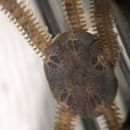Habitat
provided by Invertebrates of the Salish Sea
Lives in muddy areas, where it submerses itself in the mud and feeds by raising its arms and capturing particles from the water.
- license
- cc-by-nc-sa
- copyright
- Rosario Beach Marine Laboratory
Distribution
provided by Invertebrates of the Salish Sea
Geographical Range: Alaska to Mexico
- license
- cc-by-nc-sa
- copyright
- Rosario Beach Marine Laboratory
Comprehensive Description
provided by Invertebrates of the Salish Sea
The main plates on the aboral sides of the rays of this brittle star are oval, wider than long, and not interspersed with smaller plates. The central disk is pentagonal and the rays do not insert into notches in the central disk. There are 3 oral papillae on each side of each jaw, all of which are similar in size or the central one is slightly shorter. The rays are about 12 to 21x as long as the central disk is wide. There are 3 pointed, slightly flattened arm spines on each side of the arm plates, plus curved spines on the aboral surface of the arms. Central disk up to 9 mm diameter, appears inflated, with small, thin scales which are larger near the radial shields. Each radial shield is next to its paired shield for most of its length but separated by a row of small scales at the end nearest the center of the central disk. Overall color is reddish to grayish brown; radial shields are paler at the end nearest the rays.
- license
- cc-by-nc-sa
- copyright
- Rosario Beach Marine Laboratory
Look Alikes
provided by Invertebrates of the Salish Sea
How to Distinguish from Similar Species: Ophiopholis aculeata is commonly found here but has reddish or purplish blotches and has smaller plates between the main plates on the rays. Amphiodia occidentalis is quite similar to A. urtica but has blunt, flattened arm spines. Amphiodia periercta is also quite similar but it is reddish-brown and has arm spines not at all flattened, plus can have a larger central disk and the arm spines on the oral side are straight rather than curved.
- license
- cc-by-nc-sa
- copyright
- Rosario Beach Marine Laboratory
Comprehensive Description
provided by Invertebrates of the Salish Sea
Biology/Natural History: Sexes are separate, and lifespan is about 5 years. Predators include flatfish such as sole, plus sand stars. The arms readily break off in response to predators, and even the aboral side of the central disk can break off and be regenerated. This species is uncommon near areas with wastewater so is regarded as a bioindicator. The polychaete Malmgreniella lunulata sometimes is found living on the arms. The copepod Caribeopsis amphiodiae may live in the stomach. Carlton says that in Oregon and California this species occurs only subtidally. Can be very abundant in mud bottoms of the continental shelf.
- license
- cc-by-nc-sa
- copyright
- Rosario Beach Marine Laboratory
Habitat
provided by Invertebrates of the Salish Sea
Depth Range: Intertidal to at least 370 m.
- license
- cc-by-nc-sa
- copyright
- Rosario Beach Marine Laboratory
Amphiodia urtica
provided by wikipedia EN
Amphiodia urtica, commonly known as the burrowing brittle star or the long arm brittle star,[2] is a species of brittle star belonging to the family Amphiuridae. It is found on the Pacific coast of North America at depths down to about 370 m (1,200 ft).
Description
The central disc is pentagonal and up to 9 mm (0.4 in) in diameter. It has a somewhat inflated appearance and is scattered with small plates on the aboral (upper) side, with larger plates close to the paired radial shields at the base of the arms (rays). The five slender arms taper to a point and consist of a number of articulated joints each topped by an oval plate wider than it is long. There is a curved spine on this plate and three slightly flattened spines projecting laterally on either side of each joint on the arm. The length of each arm is from 12 to 21 times the diameter of the disc. The color of this brittle star is grayish-brown or reddish-brown, with a paler patch at the outer end of the radial shields.[2]
Distribution and habitat
Amphiodia urtica is native to the west coast of North America, its range extending from Alaska to Mexico. Although it can occur intertidally, it is more often in the subtidal zone at depths down to about 370 m (1,200 ft). It occurs on muddy bottoms where it immerses itself in the sediment, raising its arms into the water above to catch food particles floating by. On the continental shelf it can occur in large numbers.[2]
Ecology
This brittle star is predated by flatfish such as sole as well as by sand stars. The arms are most vulnerable and often get torn off or damaged, and both the arms and the aboral surface of the disc can be regenerated.[2] The sexes are separate in this species, which commonly lives for five years. A polychaete worm, Malmgreniella lunulata, sometimes lives on the arms and a copepod sometimes inhabits the stomach.[2]
References

- license
- cc-by-sa-3.0
- copyright
- Wikipedia authors and editors
Amphiodia urtica: Brief Summary
provided by wikipedia EN
Amphiodia urtica, commonly known as the burrowing brittle star or the long arm brittle star, is a species of brittle star belonging to the family Amphiuridae. It is found on the Pacific coast of North America at depths down to about 370 m (1,200 ft).
- license
- cc-by-sa-3.0
- copyright
- Wikipedia authors and editors

